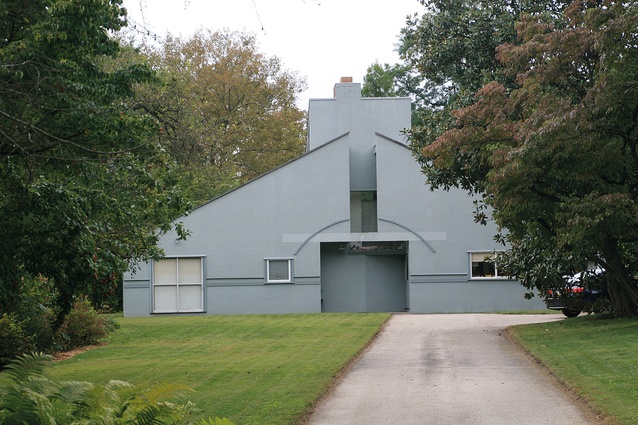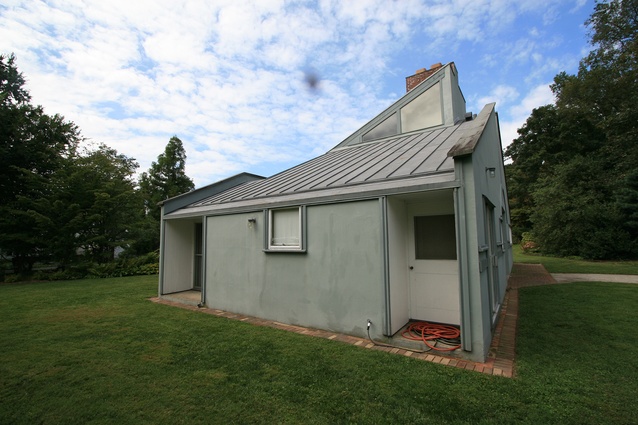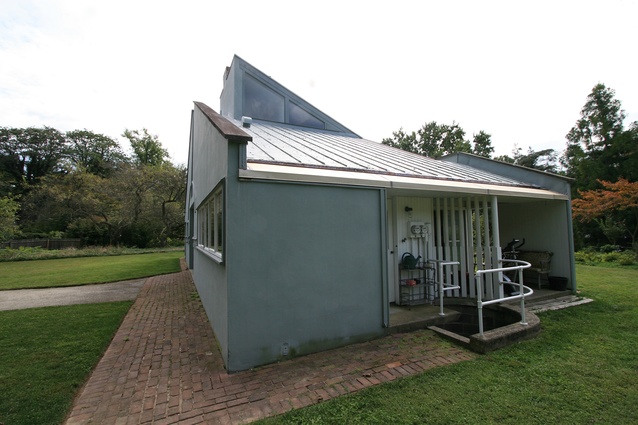Ducks in the decorated shed
Architect, academic and Post-Modernism critic Dr Peter Parkes discovers a Kiwi connection in the remote Philadelphia suburb of Chestnut Hill.
Returning from a study trip to the USA and eager to impart stories of our adventures, I happened to be sitting beside Ashley Cox on the NZIA Napier Branch tour bus visiting houses by the late Steve McGavock. Ashley was up for hearing of our exploits so I started, not with the Farnsworth House, Fallingwater or Taliesin East but the Margaret Esherick House, designed by Louis Kahn with the help of a then-young Robert Venturi, in Chestnut Hill, Philadelphia.
After viewing this house from the exterior only, my partner and I walked to the neighbouring Vanna Venturi House. As we chatted to an elderly woman walking her dog, a middle-aged man came out and joined in our conversation. As its new owner, he apologised for not inviting us in – his son was studying for final exams – but he was happy for us to walk the exterior. I explained that I had studied Venturi’s writings for my PhD thesis1 and was grateful to view the house, albeit in a limited way. As we walked the extensive front lawn, he pointed out a line of small yellow plastic ducks and a solitary black one on the kitchen window sill – the type of duck that kids play with at bath time.
For architecture scholars of my vintage, the duck metaphor was a significant part of Venturi’s argument in promoting a new populist-charged architectural theory, postmodernism, though he was indifferent to the term. Venturi saw the duck as symbolic of modernism, in its supposed physical form and its arguable state of health: a ‘dead duck’. He promulgated the idea of ‘decorated sheds’, inspired by his Learning from Las Vegas with Denise Scott Brown and Steve Izenour.2 Architecture conceived as billboards would help to repopularise it, reconnecting with ‘the people’.3 Commerce and its aesthetics were to be embraced as a saviour for the flagging social interest in architecture, rescuing it by resorting to building forms from the ubiquitous main street.

Back to the ducks on the window sill – it’s a tale after all and duck’s tails are meant to be short. On learning that I was a New Zealander, the house-owner said he and his son named the black duck after a famous All Black, Jonah Lomu. He explained that the plastic ducks were left in the house by Venturi’s mother as they were gifts from Robert Venturi’s friends and colleagues and that the black duck was gifted by a former Kiwi architect whose name he didn’t know.
Back in the bus in Hawke’s Bay, Ashley and I wondered who the architect might have been and postulated someone of a similar age and scholarly interests. We got off the bus and walked through a delightful McGavock-designed house, noting features similar to those of his former boss, John Scott, and those where he had broken free and expressed new forms and spatial connections.
In the kitchen, I was approached by a woman whom I’d met many years ago as an architecture student and she reintroduced herself as Liz Aston.4 While relaying what we’d each done in the intervening years, Liz said she had worked as a project architect for Sheppard Robson architects, who acted as consultants to Venturi Scott Brown Associates on its 1991 competition-winning Sainsbury Wing for the National Gallery in London.
I told her I’d just visited Philadelphia and some of Venturi and Scott Brown’s works, including Guild House and his mother’s house. She said she’d become good friends with Venturi and Scott Brown, particularly when living near their Philadelphia office while completing an LLM at the University of Pennsylvania and studying for the New York Bar. I told her about the ducks and the naming of the black one and, to my utter astonishment, she explained that she had given it to the current owner. She had recently visited the house with Bob and Denise and, seeing the ducks, offered to send him an All Black one in return for his hospitality. I was flabbergasted by the coincidence.
Back on the bus, and still in a state of amazement, I told Ashley that the Kiwi giftee of the duck was unbelievably in our tour party – the New Zealand connection of the black plastic duck was revealed to be none other than Liz Aston. Today, I’m still amazed by this encounter and the extremity of the coincidences. This tale is true and far from mere quackery. Architecture tours can be way more exciting than the mere gathering of CPD points.
1 Peter Parkes, ‘Post Modernism: A critique’, PhD dissertation submitted to the Welsh School of Architecture, University of Wales Institute of Science and Technology, February 1986.
2 Robert Venturi, Denise Scott Brown and Steven Izenour, Learning from Las Vegas: The Forgotten Symbolism of Architectural Form, MIT Press, 1972.
3 Refer to Peter Parkes and Alan Lipman, ‘The Engineering of Meaning: Lessons From Las Vegas recalled… and declined’, Design Studies, volume 7, issue 1, January 1986.
4 Liz Aston is General Counsel – Practice Services, Te Kāhui Whaihanga New Zealand Institute of Architects.
Note: In the Jan/Feb 2023 issue of Architecture NZ magazine (page 29), references 1 and 3 incorrectly referred to the author as Peter Parker. It is in fact Peter Parkes.














